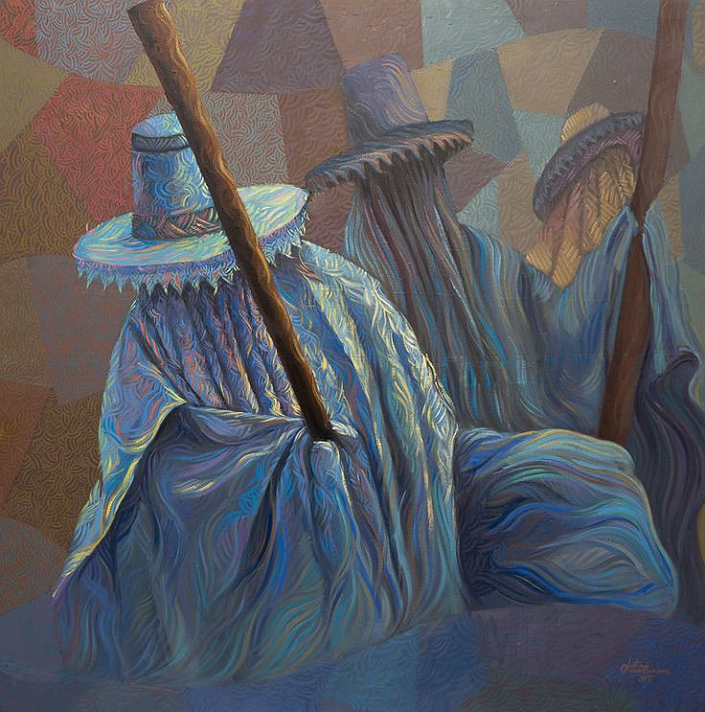Documentary Title: “Chains to Legacy: The African American Monument of Savannah”
Rising humbly by the banks of the Savannah River in Georgia stands a monument that echoes centuries of struggle, endurance, and hope: The African American Monument, unveiled in 2002. Though unassuming in size, this sculpture carries the emotional and historical weight of a people who, from bondage, carved a legacy that forever shaped the United States. More than a statue, this work of art stands as a bridge—connecting the past atrocities of the transatlantic slave trade to the ongoing journey of Black empowerment and cultural memory.
The Symbolism of the Structure:
Crafted by renowned sculptor Dorothy Spradley, the monument depicts a family of four—father, mother, and two children—embracing one another in a circle of love and unity. Beneath their feet are broken chains, a stark and sobering symbol of slavery's brutal past and the eventual emancipation that freed millions.
The chains, resting in broken silence, serve not only as a representation of physical bondage but also of psychological, social, and economic constraints. The family, standing together, is a clear symbol of resilience, a reminder that despite efforts to destroy familial bonds during slavery, the Black family survived.
The inscription on the base is perhaps the most chilling and powerful element. It includes these words from poet Maya Angelou:
“We were stolen, sold and bought together from the African continent.
We got on the slave ships together.
We lay back to belly in the holds of the slave ships in each other's excrement and urine together,
sometimes died together, and our lifeless bodies thrown overboard together.”
Angelou initially objected to including this raw truth, fearing it would offend, but later approved it after recognizing that healing requires truth.
Savannah, like many port cities, played a major role in the slave trade. African men, women, and children were offloaded, sold, and distributed into brutal labor systems throughout the American South. Yet, for generations, no public monument in the city told this story—until 2002.
This omission reflected a broader national silence. For decades, American public memory tended to sanitize or ignore slavery’s legacy. Statues of Confederate leaders littered the South, but no monuments honored the Black people who endured and resisted their oppression.
The African American Monument broke that silence.
Cultural and Social Impact
1. A Place of Reflection and Truth
For Black Americans, especially descendants of enslaved Africans, the monument offers a sacred space to mourn, reflect, and connect with ancestral pain and power. Tourists and locals alike gather around it—not just to take pictures, but to read the inscription, touch the bronze, and meditate.
2. Educational Importance
Schools in Savannah and surrounding areas now include the monument in educational tours. It gives students, both Black and non-Black, a tangible connection to history—not as abstract facts, but as lived experience. This has deepened awareness of systemic racism and the endurance of African American culture.
3. Empowerment and Healing
Psychologically, the monument has helped reclaim a narrative. It shifts the Black identity from victimhood to survival and strength. It says: "We are still here. We remember. And we honor those who came before us."
4. Political and Social Awarenes
The monument has also fueled discussions about race, reparations, and historical memory. It has inspired other cities to consider similar memorials. Its presence has become a quiet but persistent form of activism—challenging the public to reckon with slavery not just as a thing of the past but a root of ongoing disparities.
In the wake of events like the Charleston Church massacre, George Floyd’s murder, and the Black Lives Matter movement, the monument has become a rallying point. Candles, flowers, and protest signs have appeared around it, transforming it into a place of vigil and resistance.
It reminds viewers that the journey from chains to freedom is ongoing. Racism, inequality, and trauma persist—but so does the unbreakable spirit of a people who, despite centuries of struggle, continue to build, create, and lead.
The African American Monument in Savannah is more than bronze and stone. It is a living testament to the enduring legacy of Black Americans. It speaks of pain, but also of survival. Of injustice, but also of triumph. Its history and meaning continue to benefit the Black community today by offering truth, inspiration, and a sense of sacred connection.
In a nation still wrestling with its racial past and present, monuments like these don’t just remember—they teach, challenge, and heal.
Rising humbly by the banks of the Savannah River in Georgia stands a monument that echoes centuries of struggle, endurance, and hope: The African American Monument, unveiled in 2002. Though unassuming in size, this sculpture carries the emotional and historical weight of a people who, from bondage, carved a legacy that forever shaped the United States. More than a statue, this work of art stands as a bridge—connecting the past atrocities of the transatlantic slave trade to the ongoing journey of Black empowerment and cultural memory.
The Symbolism of the Structure:
Crafted by renowned sculptor Dorothy Spradley, the monument depicts a family of four—father, mother, and two children—embracing one another in a circle of love and unity. Beneath their feet are broken chains, a stark and sobering symbol of slavery's brutal past and the eventual emancipation that freed millions.
The chains, resting in broken silence, serve not only as a representation of physical bondage but also of psychological, social, and economic constraints. The family, standing together, is a clear symbol of resilience, a reminder that despite efforts to destroy familial bonds during slavery, the Black family survived.
The inscription on the base is perhaps the most chilling and powerful element. It includes these words from poet Maya Angelou:
“We were stolen, sold and bought together from the African continent.
We got on the slave ships together.
We lay back to belly in the holds of the slave ships in each other's excrement and urine together,
sometimes died together, and our lifeless bodies thrown overboard together.”
Angelou initially objected to including this raw truth, fearing it would offend, but later approved it after recognizing that healing requires truth.
Savannah, like many port cities, played a major role in the slave trade. African men, women, and children were offloaded, sold, and distributed into brutal labor systems throughout the American South. Yet, for generations, no public monument in the city told this story—until 2002.
This omission reflected a broader national silence. For decades, American public memory tended to sanitize or ignore slavery’s legacy. Statues of Confederate leaders littered the South, but no monuments honored the Black people who endured and resisted their oppression.
The African American Monument broke that silence.
Cultural and Social Impact
1. A Place of Reflection and Truth
For Black Americans, especially descendants of enslaved Africans, the monument offers a sacred space to mourn, reflect, and connect with ancestral pain and power. Tourists and locals alike gather around it—not just to take pictures, but to read the inscription, touch the bronze, and meditate.
2. Educational Importance
Schools in Savannah and surrounding areas now include the monument in educational tours. It gives students, both Black and non-Black, a tangible connection to history—not as abstract facts, but as lived experience. This has deepened awareness of systemic racism and the endurance of African American culture.
3. Empowerment and Healing
Psychologically, the monument has helped reclaim a narrative. It shifts the Black identity from victimhood to survival and strength. It says: "We are still here. We remember. And we honor those who came before us."
4. Political and Social Awarenes
The monument has also fueled discussions about race, reparations, and historical memory. It has inspired other cities to consider similar memorials. Its presence has become a quiet but persistent form of activism—challenging the public to reckon with slavery not just as a thing of the past but a root of ongoing disparities.
In the wake of events like the Charleston Church massacre, George Floyd’s murder, and the Black Lives Matter movement, the monument has become a rallying point. Candles, flowers, and protest signs have appeared around it, transforming it into a place of vigil and resistance.
It reminds viewers that the journey from chains to freedom is ongoing. Racism, inequality, and trauma persist—but so does the unbreakable spirit of a people who, despite centuries of struggle, continue to build, create, and lead.
The African American Monument in Savannah is more than bronze and stone. It is a living testament to the enduring legacy of Black Americans. It speaks of pain, but also of survival. Of injustice, but also of triumph. Its history and meaning continue to benefit the Black community today by offering truth, inspiration, and a sense of sacred connection.
In a nation still wrestling with its racial past and present, monuments like these don’t just remember—they teach, challenge, and heal.
Topic Live























